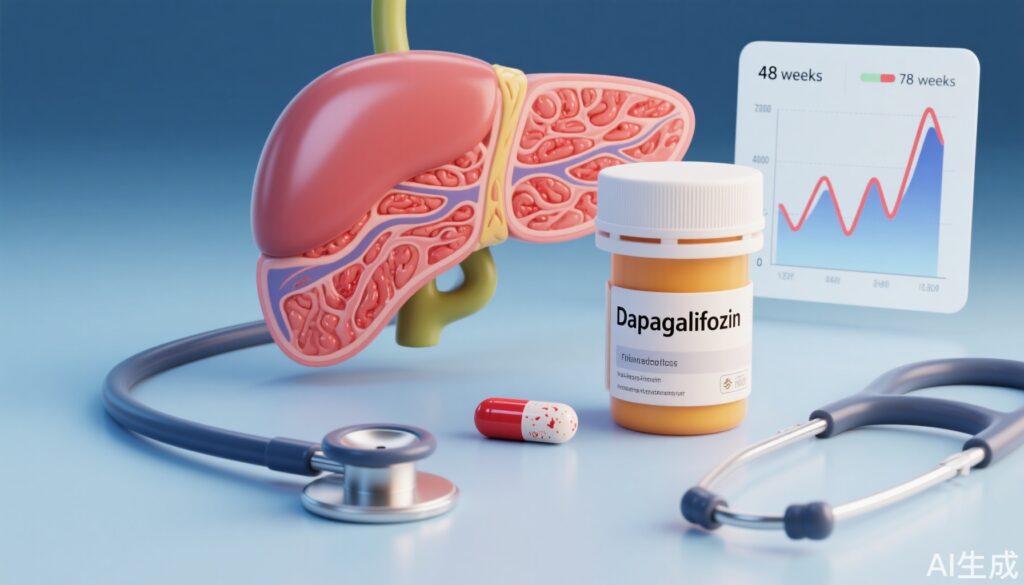Highlight
– Dapagliflozin treatment improved MASH activity scores and fibrosis outcomes significantly compared to placebo.
– MASH resolution without fibrosis worsening was nearly threefold higher in the dapagliflozin group.
– Fibrosis improvement occurred in 45% of treated patients without increased adverse events.
– The treatment was well tolerated, with very low rates of discontinuation due to adverse events.
Study Background and Disease Burden
Metabolic dysfunction-associated steatohepatitis (MASH), often overlapping with non-alcoholic steatohepatitis (NASH), represents a progressive form of non-alcoholic fatty liver disease (NAFLD). MASH is characterized by liver inflammation and hepatocyte injury in the setting of metabolic risk factors such as diabetes and obesity, frequently leading to fibrosis and cirrhosis. Despite the growing global burden of MASH, especially in populations with increasing rates of metabolic syndrome, there remains a paucity of approved pharmacotherapies with demonstrated efficacy and safety. Sodium-glucose cotransporter 2 (SGLT2) inhibitors like dapagliflozin have emerged as potentially beneficial agents due to their metabolic effects and possible anti-inflammatory properties. However, high-quality clinical trial evidence assessing dapagliflozin’s impact on histologically confirmed MASH has been limited until now.
Study Design
This was a multicentre, double-blind, randomized, placebo-controlled trial conducted across six tertiary hospitals in China between November 2018 and March 2023. A total of 154 adult participants with biopsy-confirmed MASH, regardless of type 2 diabetes status, were enrolled. Participants were randomized 1:1 to receive 10 mg of oral dapagliflozin once daily or a matching placebo for 48 weeks. The primary endpoint was defined as MASH improvement, measured by a reduction of at least 2 points in the non-alcoholic fatty liver disease activity score (NAS) or achieving a NAS ≤3 points, without any worsening in liver fibrosis stage. Secondary endpoints included MASH resolution without fibrosis worsening and fibrosis stage improvement without worsening of MASH. Analyses were performed on the intention-to-treat dataset.
Key Findings
The trial demonstrated that 53% of participants treated with dapagliflozin achieved MASH improvement without fibrosis worsening, compared with 30% in the placebo group (risk ratio [RR] 1.73, 95% confidence interval [CI] 1.16 to 2.58; P=0.006). The mean decrease in NAS was significantly greater in the dapagliflozin group by 1.39 points (95% CI -1.99 to -0.79; P<0.001).
Regarding MASH resolution without fibrosis worsening, dapagliflozin nearly tripled the response rate compared to placebo (23% vs 8%; RR 2.91, 95% CI 1.22 to 6.97; P=0.01). Fibrosis improvement without worsening of MASH occurred in 45% of treated patients versus 20% in controls (RR 2.25, 95% CI 1.35 to 3.75; P=0.001).
Safety profiles were favorable, with only 1% of patients discontinuing dapagliflozin due to adverse events compared to 3% in the placebo group, indicating excellent tolerability over the 48-week period.
Expert Commentary
This trial is among the first large-scale, biopsy-proven studies to establish the efficacy and safety of dapagliflozin in improving both MASH histological activity and fibrosis progression. These findings align with the growing understanding that SGLT2 inhibition not only improves glycemic control but may beneficially modulate hepatic inflammation and fibrogenesis through systemic metabolic improvements and direct hepatic effects. The inclusion of patients with and without type 2 diabetes broadens the generalizability of these results.
Nonetheless, longer-term studies are warranted to assess whether these histological improvements translate into meaningful clinical outcomes such as reduced liver-related morbidity and mortality. Additionally, mechanistic studies exploring dapagliflozin’s impact on inflammatory pathways and fibrotic remodeling in liver tissue would enhance understanding.
Conclusion
Treatment with dapagliflozin for 48 weeks significantly improves metabolic dysfunction-associated steatohepatitis activity and fibrosis without increasing adverse events, making it a promising therapeutic option. The substantial increases in MASH improvement and resolution rates, alongside fibrosis regression, highlight dapagliflozin’s potential to fill an important gap in MASH management, pending further confirmatory and long-term outcome studies.
References
Lin J, Huang Y, Xu B, et al. Effect of dapagliflozin on metabolic dysfunction-associated steatohepatitis: multicentre, double blind, randomised, placebo controlled trial. BMJ. 2025 Jun 4;389:e083735. doi: 10.1136/bmj-2024-083735. PMID: 40467095; PMCID: PMC12135075.
ClinicalTrials.gov Identifier: NCT03723252.



